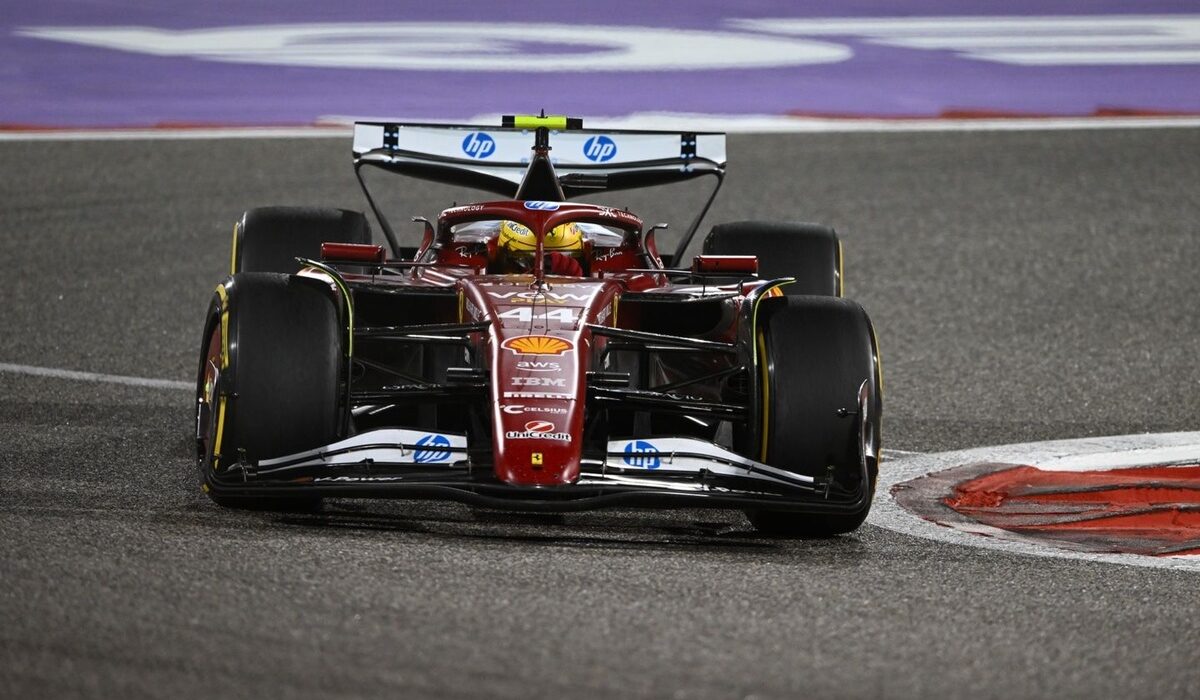After seemingly hitting rock bottom morale-wise in qualifying for the 2025 Bahrain Grand Prix, Lewis Hamilton rebounded by guiding his Ferrari to fifth place from ninth on the grid. Team-mate Charles Leclerc was fourth after starting second.
For Hamilton, this was arguably the best result possible without retirements ahead.
Afterwards, Hamilton was the most upbeat he has been since winning the sprint race in China, suggesting he had made a breakthrough in understanding the car, and how he needs to adapt to get the best out of it.
Brake feel is crucial for Hamilton
Lewis Hamilton, Ferrari, Andrea Kimi Antonelli, Mercedes
Photo by: Clive Rose / Getty Images
“What’s clear is that, as humans, we really get stuck in our ways,” Hamilton said to Sky Sports F1. “And I feel like I’ve been driving a car with the same team for such a long time… and I’ve move to a new car and it requires such different driving style and settings.
“I’ve been using engine braking, which I’ve never used in my previous years. Much different brakes – we’re on Brembos, I’ve been on CIs [Carbone Industrie] for the past 15 years or so.
“The car requires a much different driving style. So I’m adjusting to that, and I think I’m slowly getting it into my head, and getting the balance right.
“What Charles does is he starts with a set-up, and he stays with it pretty much all weekend, and last week and this weekend I was a long way away from him, then just before qualifying I got close to him but then the settings were all off. I’ve got to do a better job through the weekend and I will.”
“I’ve got to make it easy for myself – I’m doing it all the hard way at the moment. I’ll try next week to start in a better place and not deviate too much. As I said, I think I’ve figured out how the car likes to drive so if I apply that next week, if I can qualify better I’ll have a much better weekend.
The choice of brake manufacturer might seem like an abstruse point but, at the point of interface with the driver, the braking process is a combination of muscle memory and feel. The driver becomes accustomed not just to the bite point of the brakes, but the strength of the initial bite and the progression of the braking effort, through to the sensations transmitted through the pedal that the lock-up point is imminent.
Making the right strategy calls
Lewis Hamilton, Ferrari
Photo by: Zak Mauger / Motorsport Images
In Bahrain, both Ferraris ran a different strategy to the majority of the field, starting on medium-compound tyres while rest of the top 10 started on used softs.
While Leclerc lost two positions at the start – to George Russell and Lando Norris – Hamilton held on to ninth and soon passed Carlos Sainz’s Williams for eighth. Although the second Red Bull of Yuki Tsunoda undercut Hamilton at the first stops, Lewis made his way by within two laps and nailed a pass for position on Yuki’s team-mate Max Verstappen three laps after that.
Andrea Kimi Antonelli and Pierre Gasly, who also started ahead of Hamilton, lost out by pitting shortly before the safety car was deployed on lap 32. Lewis even had a brief dice with Lando Norris after the restart before the McLaren slipped away. Thanks to Verstappen’s woes Hamilton faced no serious threat from behind so was able to absorb more lessons in how the Ferrari needs to be driven.
But the priority now is to find a way to nail those crucial laps in qualifying, since car convergence means small time losses can add up to a large disparity in grid positions.
“You won’t replace 12 years of collaboration in two weeks or two races,” said Ferrari team principal Frederic Vasseur in his post-race media briefing. “For sure we need to improve but this is true for everybody in the paddock: the DNA of our sport is for everybody to do a better job.
“It’s good to have Lewis with this mindset: ‘I have to improve myself, and to adapt myself to the car.’ We will adapt the car to Lewis but he also has to do a step.
“Between us, it’s done in a very positive and constructive way. Three or four years ago, if you made a mistake and were four or five tenths behind your team-mate you maybe lost one row, now you lose six or seven positions.
“Charles was on the second row but three or four hundredths slower and he would have been P6, so we have to stay calm.”

